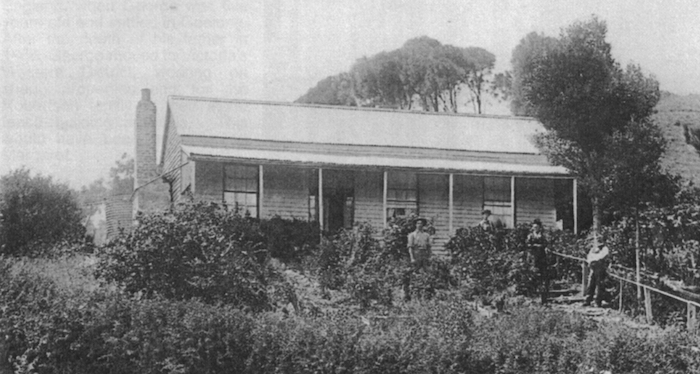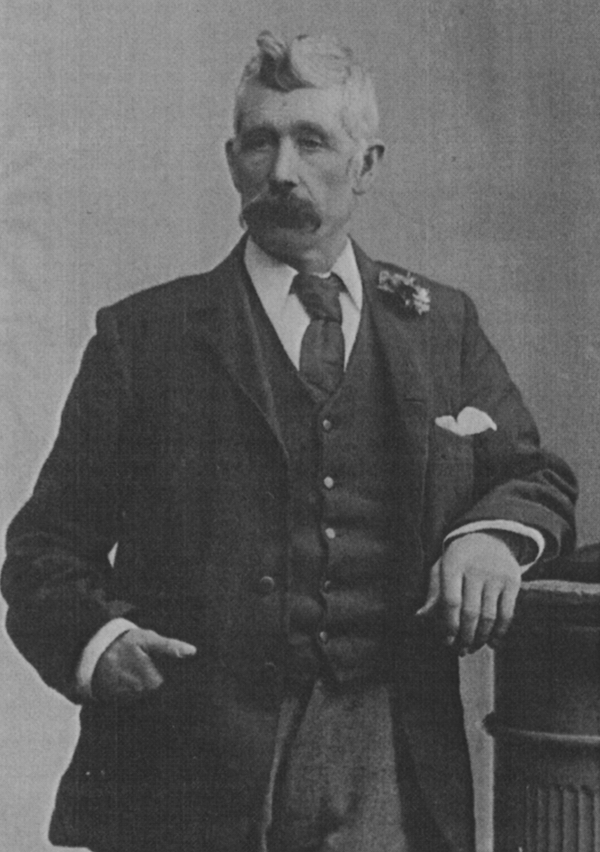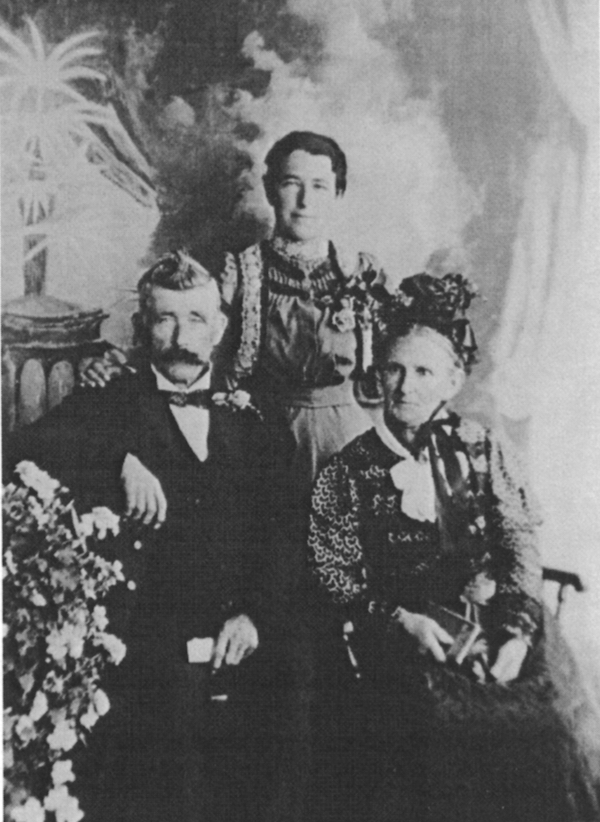

The Folk from the Wind Wound Isle > Arthur Robertson
page 41
Born 1848 - Died 1925

Arthur was born at Hellister, Shetland on 22 June 1848, the fourth son and sixth surviving child of Arthur Robertson and Margaret Henderson. He came to Australia with his sisters Agnes and Margaret on the John Temperly, arriving in September 1867. On the shipping list he is recorded as ‘farmer’, but it is understood in the family that he worked his passage, possibly as a helmsman.
At the age of twenty-seven, Arthur married Margaret Rutherford CAIRNS (1830-1914) at Margaret’s Derrinallum property, on 3 September 1875. Margaret was forty-five years old. Their only child, Willimina Jemima Edith (Mime) Robertson, was born two months later at Skipton. Margaret was a widow with twelve children. On the marriage certificate her occupation is recorded as ‘sheep farmer’, Arthur’s as ‘stonewaller’. One of the witnesses was Arthur’s brother James. The name of the other witness is illegible.
Margaret was born at Bridge of Allan, Scotland the daughter of John Rutherford (a doctor of medicine) and Margaret Stewart. Five months before Arthur and Margaret were married, Arthur’s brother Robert had married Margaret’s daughter Mary Jane (Molly) Cairns (See Chapter 11.)
There seem to be two sides to the story of Arthur and Margaret’s marriage. My mother Lottie Dickins, who was the daughter of Mary Jane Robertson nee Cairns tells us, “Margaret’s first husband George Cairns planned that his children should be trained for professions and he left a will stating that his estate was not to be divided until the last of the children reached 21. However after their marriage Arthur and Margaret moved to Port Campbell and Arthur sold all the movable stock and equipment for his own use. The trustees of the will did not stop him.” 1
The impression Lottie got from her mother was that George Cairns’ children were resentful of Arthur’s action, because instead of being educated they had to work on the farm and got little when the estate was finally wound up.
The other side of the story comes from Marjorie Mathieson, who gained the impression from her father that the Robertsons thought Margaret Rutherford Cairns was onto a pretty good thing getting a young husband.
Arthur and Margaret moved to Port Campbell. Margaret’s younger children presumably went with them as Samuel and Kate Cairns are listed among the first pupils at the Port Campbell School in 1877. Her eldest son George Cairns also moved to Port Campbell and worked as a blacksmith as his father had done before him. Some of his descendants still live in the area.

Arthur took up 18 acres on Lot 12, next to his father’s selection. This was not a large piece of land and money from the vegetables he grew would not have been enough to support the family. 2 Arthur had a shearing shed and he had a marine lease on the coast between the Sherbrooke River and Campbell’s Creek, which was about five miles long by one mile wide. Here he grazed sheep and he made more money from this than anyone realized, leaving about £1000 when he died.
< Arthur Robertson with his wife Margaret and their daughter Willimina
In December 1880, Arthur Robertson placed an advertisement in the Camperdown Chronicle: “a summer residence at the seaside of from one to five rooms can be obtained with or without boarding”. 3 This may have been Arthur Jnr or it may have been his father. Either way it looks as if the Robertsons were taking advantage of the growing development of Port Campbell as a holiday resort.
Like his brothers Arthur was an evangelist. In a letter to the Rev S Chapman of the Baptist Church, dated 29 October 1889, James Magilton writes from Yarma Station near Cressy, that he is “at present with Arthur Robertson conducting the Shearer’s Mission.” 4
Arthur was a member of the lifeboat and rocket crew at Port Campbell. The story of the wreck of the Fiji on 5 September 1891 at Moonlight Head, an uninhabited section of the coastline 16 miles east of Port Campbell, is related in several books. 5 Arthur was one of those attending the rescue operations and his brother Robert writes about the rescue in dramatic fashion:
As captain of the Port Campbell life-boat crew, Arthur, with his own team, rushed with the life-line to the scene of the wreck of the Fiji, and the crew came to shore, hand over hand, on that thin line through the
page 43
surging waters, sometimes on the waters and sometimes under the water - mostly under the waters - for seventeen of them were at one time on the line, all clinging and struggling for dear life in the briny, swirling waves. 6
Gus Ward told me his great grandfather’s story when I visited him in April 2000. The interview was recorded on tape and I have done a small amount of editing.
Arthur was in the rocket crew and they took the first cart, which was a spring cart, out to the Fiji, which was probably 4 to 6 hours drive, out to Moonlight Head and the Ocean Road, the track, went right on the cliff top. They got the first gear there with the rocket and the small equipment and were able to fire a rocket across the ship. And he [Arthur] was said to be the one to fire the rocket getting the light equipment across. It was his job. Now what I am telling you is authentic ’cause the man who told me this story was the Methodist home missionary from Cobden who was sent out to bury the bodies of the dead that were washed up the next day. He had to ride a horse from Cobden to Moonlight Head. Now what happened, the heavy equipment from Port Campbell had to be brought by horse and dray which was much slower and they set up a signal or a message on the cliff face to wait for a number of hours till the heavy equipment came. But the sailors decided to come hand over hand across the line to the shore, and there were eleven coming hand over hand on the line when a big sea came and took the lot of them into the sea and drowned the eleven. Later when the heavy equipment did arrive and they could get the breeches buoy across, they saved the captain and some others. The captain was brought in here and stayed in Arthur’s house for two or three nights until there was a train going from Camperdown to Melbourne. Subsequent to that, because my grandmother [Mime] was learning the organ, he sent her a gift of a music case, and I’ve seen that. It was beyond repair and had to be discarded eventually.
Lottie believed there was a film made of the Port Campbell rocket crew, with Arthur directing a practice with lifeboat and rockets. Robert, Lottie’s father, had seen this film and he mentions it in the section about Arthur in The Port Campbell Revival. I tried to locate the film through the National Film Archives and the Victorian State Library but have found no trace of it, nor of anyone else who has seen or heard of it.

Arthur Robertson's house at Port Campbell
In the garden are from left to right: Chris Ward, Willimina, Margaret, and Arthur.
Margaret Rutherford Cairns Robertson died in 1914 at the age of eighty-four. She was an interesting person who sounds as if she had a strong character. She deserves a separate account of her life. Lottie felt close to her maternal grandmother and lived with her at different times. I have stories about Margaret Rutherford that Lottie has handed on to us. The lives of
page 44
her Cairns descendants are intertwined or run parallel with those of the Robertson descendants at Port Campbell.
In 1918 Arthur was married for the second time, to Eliza Perry GRIFFITHS, his housekeeper. Eliza, who was sixty-one years of age, had been previously married, had one child and was widowed in 1898. She was born in Monmouthshire, South Wales to Simon Jones and Margaret James. The marriage of Eliza and Arthur took place at ‘Blackwood Bank’, Port Campbell, in a service conducted by Baptist minister Walter Ward. The witnesses were Arthur’s niece, Ann Adie (Nan) Robertson, and his daughter Willimina Ward.
Arthur kept a rowing boat down at Campbell Creek. He would go out in this and guide incoming ships around the reef. He believed that one day it would be possible to dredge the swamp area in the lower section of Campbell’s Creek and make a good harbour. Two of the boats that used to come to Port Campbell in the 1920s were the Doris and the Gem. They carried about 100 tons of cargo, bringing in stores and taking out cheese, sheepskins and oats. The cheese came from factories at Lower Gellibrand and Princetown. It was brought down the Gellibrand River by barge, and from Princetown by horse and dray to Port Campbell.
By this time Arthur and his sister Margaret were the only generation ‘B’ Robertsons still living at Port Campbell. Arthur continued taking an active part in the local community. He is mentioned a number of times in Fletcher’s books about the Heytesbury Shire. As part of his missionary work he had the ‘oversight’ of the Port Campbell Baptist Church from 1892 to 1925. Arthur died at the age of seventy-seven in 1925. He and Margaret Rutherford are buried in the Robertson family grave at Port Campbell.
Until recently Gus Ward, one of Arthur and Margaret’s great grandsons was still living at Port Campbell, on land selected by his great grandfather. According to Gus’ brother Chris Ward, this land did not revert to the family until after the death of Arthur’s second wife. 8
1 From notes dictated by Lottie Dickins to Marie Nemec
2 Interview with Gus Ward, April 2000
3 J. Fletcher, The Infiltrators, p.252
4 A copy of this letter was supplied by Matthew Magilton who found it in the Victorian Baptist Historical Society records. At Robert Robertson’s suggestion James Magilton is writing to ask for work with the Home Missionary Society. James Magilton worked as a home missionary until his death from tuberculosis at the age of twenty-nine, in 1894.
5 For example: M. McKenzie, Shipwrecks ... and More Shipwrecks, McKenzie, Peterborough, Victoria, 1974
6 R. Robertson, The Port Campbell Revival
7 Interview with Gus Ward, April 2000
8 Letter from Chris Ward, February 2001
Garry Gillard | New: 13 March, 2019 | Now: 5 September, 2022